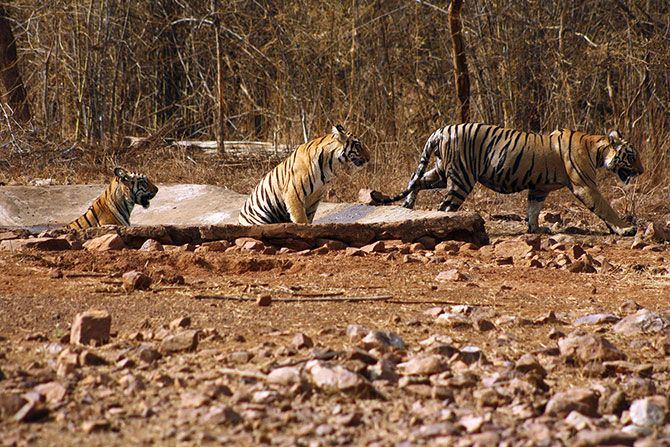 Have India's tigers increased by 30 per cent in the last four years?
Have India's tigers increased by 30 per cent in the last four years?
Some scientists question the numbers. Rashme Sehgal reports for Rediff.com on the debate.
Scientists across the globe are questioning whether India's tiger population has actually increased by 30 per cent in the last four years.
The recent tiger census released by the National Tiger Conservation Authority, NTCA, stated in January 2015 that the tiger numbers had risen from 1,702 to 2,206 in the last four years.
Now a team of scientists from Oxford University, the Wildlife Conservation Society and the Indian Statistical Institute insist that the methodology of index calibration being used by the NTCA has shortcomings.
Index calibration comprises of measuring animal numbers in a relatively small region using reliable, intensive and expensive methods including camera trapping and then relating this measure to a more easily obtained inexpensive indicator such as animal track counts.
The calibrated index is then used to extrapolate the actual numbers over larger regions.
The new study chose to investigate the index calibration by creating a mathematical model describing the approach and then testing its efficiency with different values representing variations in data which were inputted.
The model was shown to lose its efficiency and power to predict under these different conditions. The team then tested this mathematical model in a real world example -- by attempting to derive tiger numbers from fieldwork data in which the index calibration model was shown to be unreliable with little degree of success.
Dr Arjun Gopalaswamy, a lead author of the report from the Wildlife Conservation Research unit at Oxford's department of zoology pointed out that the index calibration models were so fragile that even a 10 per cent uncertainty in detection rates severely compromised what could be inferred from the data.
Professor David Macdonald, co-author of this study and also a founding director of the Wildlife Conservation Research Unit at Oxford's department of zoology, said, 'This is a breakthrough which will dramatically change how we count wildlife numbers in the future.'
Professor Mohan Delampady, a co-author from the Indian Statistical Institute, said, 'The findings have wider consequences for several applied sciences where sampling and direct extrapolation is involved, especially when sampling errors are influenced by unknown detection probabilities.'
'Calibration can work well, if the correlations are tight and consistent, but often they aren't, and many of us, myself included, for example in the context of estimating numbers of mink and water voles in the UK, have been using the technique without appreciating its risks,' Professor Macdonald said.
'Our intention is to help conservationists by highlighting the conditions when index calibration can be misleading. Everybody will benefit from greater accuracy when it comes to counting rare animals,' he added.
'Index calibration relies on the assumption that detection rates of animal evidence are high and unvarying,' Dr Gopalaswamy said. 'In reality, this is nearly impossible to achieve. Instead, there are many flexible approaches, developed over the past decade by statistical ecologists, which can cut through noisy real world data to make accurate predictions.'
Dr Ullas Karanth, a co-author from the Wildlife Conservation Society and a member of NTCA says, "This study exposes fundamental statistical weaknesses in the sampling, calibration and extrapolations that are at the core of methodology used by the government to estimate India's numbers, thus undermining their reliability."
 "We are not at all disputing that tigers numbers have increased in many locations in India in the last eight years," Dr Karanth said, adding, "but the method employed to measure this increase is not sufficiently robust or accurate to measure changes at regional and country wide levels."
"We are not at all disputing that tigers numbers have increased in many locations in India in the last eight years," Dr Karanth said, adding, "but the method employed to measure this increase is not sufficiently robust or accurate to measure changes at regional and country wide levels."
On why he had not expressed his reservations in the NTCA itself of which he was a member, Dr Karanth says, "I have expressed reservations of Phases I, I, and III of the survey method, but fully endorse the Phase IV section 3 protocols."
"I have, repeatedly in meetings as well as in consultations and in my publications expressed reservations. One positive response was to include Phase IV section 3 protocols in the 2014 survey, which I think if applied correctly will give good results. Other suggestions were ignored."
Whether the index calibration method was faulty and what would he suggest as an alternative, he says, "I would like a full implementation of Phase IV section 3 in all important source populations, and using occupancy modeling in the wider landscapes once in 4, 5 years."
Discussing whether a 30 per cent increase in the tiger population is feasible -- given the large number of tigers which were poached and also the fact that several tiger reserves in Odisha and Jharkhand and Bihar have seen numbers decline -- Dr Karanth says, "The index calibration based on double sampling cannot give reasonable estimates. Tiger numbers have increased in many areas in Karnataka, MP, Uttarakhand, Maharashtra and tigers are doing well in a few. But the tribal belts have failed to recover tiger numbers."
Tiger expert Valmik Thapar did not want to muddy his feet in this controversy, stating that this is an issue that only scientists could resolve.
"As many as 1,534 tigers were spotted in the camera traps," says Thapar. "The number of cameras have increased. I believe the NTCA findings are backed by science."
Dr V Jhala of the Wildlife Institute strongly defends the index calibration methodology which has shown up this steep rise. "We all knew that the tiger numbers have gone up. But none of us expected this kind of number. We were expecting the number to be around 1,900," he says, adding that data on each tiger had been checked and rechecked.
One reason for this increase in numbers is that the tiger corridors, which the animals use for moving from one habitat to the other, have been functioning smoothly.
The next step in tiger conservation, says Dr Jhala, would be to designate these tiger corridors as eco-sensitive areas so that when any industrial or infrastructure projects are carried out, the criticality of these areas for tigers is accounted for.
Images: Top: A tiger in the Bandhavgarh National Park, Madhya Pradesh. Photograph: Sonil Dedhia/Rediff.com
Bottom: Tigers in the Tadoba National Park, Maharashtra. Photograph: Sonil Dedhia/Rediff.com










